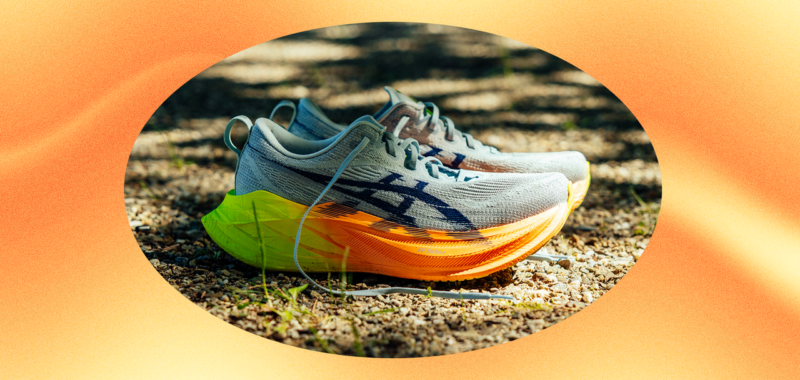The Asics Superblast 2 could’ve been a drag. With a cult-like following, the original Superblast was beloved for ushering a new footwear genus: the super trainer. They’re no super shoe—you know the one: carbon fiber plate, big foam outsole, $250 (or more)—because that’s a totally different category of runner, one that’s calceus non grata—banned, outlawed, and against the rules, according to the World Athletics Association. Where super shoes are made almost exclusively for racing, super trainers do everything else. To achieve this they often employ some of the components—like high-grade foam, or a nylon plate instead of a carbon fiber one—or ideas built into their competitive counterparts. In the Superblast, the spec includes a slab of Asics’ best midsole foams and a light upper. When it came out in 2022, a lot of runners seemed confused by the shoe. What exactly was it for? Those who stuck with it mile after mile after mile learned the answer: everything.
I ran my own pair of Superblasts into the ground. I wore them for long runs, short runs, recovery runs, and tempo workouts (and, don’t strip me of my medal, a half marathon, too). I put more than 500 miles on my pair before it felt like it was time to retire them. Serendipitously, Asics announced the Superblast 2 soon after. The new version is updated but not overhauled; still, anybody who’s loved a shoe only to see it remodeled into junk knows the apprehension that accompanies new releases. Nervously, excitedly, I laced up and hit the road to see how the Superblast 2 compares to its predecessor.
Specs
- Weight: 8.8 oz (size 9)
- Drop: 8 mm
- Stack Height: 45 mm heel, 37 mm toe
- Materials: engineered mesh upper, FF Blast Plus Eco and FF Turbo Plus foam, AsicsGrip outsole
- Size Range: 3.5 to 13
How do they look?
“Superblast” is a pretty conspicuous name, even for a running shoe. But it’s a name that fits—the giant (and, remember, race-illegal) wedge of foam it stands on urges double-takes, especially in the orange-to-yellow ombre that Asics released the Superblast 2 with. Like many super shoes, it extends out far beyond the back of the heel to help with stability, stride transitions, and rebound. But you don’t need prior knowledge to recognize that this isn’t a typical running shoe; my mom, who isn’t one to keep up with the aesthetic developments of running shoes, saw me lacing up for a 14 miler and had only this to say: “Wow, look at those!”
The upper, an engineered woven mesh, doesn’t draw as much attention. It looks more normal, more expected. Compared to the OG Superblast, the newer model is slightly more structured like what you’d expect on a typical daily loop running shoe. Taken in as a whole, the Superblast 2 doesn’t look like it’s going to be lightweight, and honestly, it sort of looks the opposite—but then you pick one up to get going and you’re pleasantly surprised that all that rubber can weigh so little (roughly 8.8 ounces, to be precise).
How do they fit?
There are fewer surprises once you get the Superblast 2 on. That, in a way, is a surprise in itself. What I mean is that the shoe feels sort of… normal. The Asics Metaspeed looks like a super shoe and when you put it on it feels like one too—springy, cushiony.. But the Superblast 2 might remind you of other shoes you’ve worn—it’s got that extra lift, sure, but it doesn’t feel wobbly or spring-loaded, and the upper feels snug from heel to midfoot and leaves room for the toes to wiggle.
As I tightened the laces to go for my first run in the Superblast 2—five miles down the dirt road near my place, then five miles back home—I noticed something that gave me pause. This new upper seemed a little stiff, and the tongue (which is gusseted so it won’t float around, a nice feature) seemed to be bunching up a lot as I tied my knot. But it didn’t feel bunchy on the top of my foot; I adjusted it again, it seemed to bunch up again, and I took off anyways. That was the last time I noticed the tongue, and the stiffness of the upper seemed to fade away or break in after those first miles. A close call, I thought (more likely: Asics knows what they’re doing).
How do they wear?
During those first miles, somewhere around the chicken farm where Great Pyrenees bark at me as I trot by, I was relieved and convinced that the changes Asics had made in the Superblast 2 were granular. They don’t go unnoticed though—in addition to that adjusted upper the new foam stack includes FF Turbo Plus, the company’s super shoe foam. It’s lighter and more responsive, which translated to the shoe feeling a little softer underfoot than its predecessor as I plodded along the pavement. A lot of runners (though not me) thought the first version needed 10 to 20 miles to break in; they’ll be pleased with the update.

